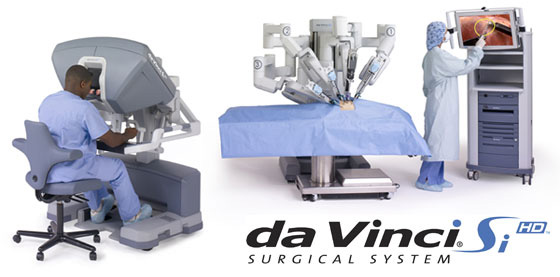Robotic surgery is a type of minimally invasive surgery. “Minimally invasive” means that instead of operating on patients through large incisions, we use miniaturized surgical instruments that fit through a series of quarter-inch incisions.
When performing surgery with the da Vinci Si—the world’s most advanced surgical robot—these miniaturized instruments are mounted on three separate robotic arms, allowing the surgeon maximum range of motion and precision.
The da Vinci’s fourth arm contains a magnified high-definition 3-D camera that guides the surgeon during the procedure.
The surgeon controls these instruments and the camera from a console located in the operating room. Placing his fingers into the master controls, he is able to operate all four arms of the da Vinci simultaneously while looking through a stereoscopic high-definition monitor that literally places him inside the patient, giving him a better, more detailed 3-D view of the operating site than the human eye can provide.
Every movement he makes with the master controls is replicated precisely by the robot. When necessary, the surgeon can even change the scale of the robot’s movements: If he selects a three-to-one scale, the tip of the robot’s arm will move just one inch for every three inches the surgeon’s hand moves.
And because of the console’s design, the surgeon’s eyes and hands are always perfectly aligned with his view of the surgical site, minimizing surgeon fatigue.
The ultimate effect is to give the surgeon unprecedented control in a minimally invasive environment. As one of our surgeons notes, “It’s as if I’ve miniaturized my body and gone inside the patient.”
Utilizing this advanced technology, our surgeons are able to perform a growing number of complex urological, gynecological, cardiothoracic and general surgical procedures.
Since these procedures can now be performed through very small incisions, our patients experience a number of benefits compared to open surgery, including:
- Less trauma on the body
- Minimal scarring, and
- Faster recovery time
About the Da-Vinci Si Surgical Robot
In 2008, NYU Langone became the first medical center in New York and New Jersey to begin using the da Vinci Si, the world’s most advanced computer-assisted surgical system. This updated model incorporates a number of innovations that enable surgeons to operate more effectively and efficiently than ever.
How the da Vinci Si Works
The da Vinci Si has two separate but connected sections:
The tower, which is positioned directly over the patient during surgery, contains the robot’s four arms—three that can hold a multitude of different surgical instruments, and a fourth that holds the system’s 3-D cameras. These arms are controlled by a computer that exactly replicates the movements of the operating surgeon.
The console is where the surgeon sits and operates the robot’s controls while looking into a stereoscopic monitor that provides a magnified, high definition 3-D view of the surgical site. The surgeon manipulates the robot’s four arms by maneuvering two master controls that provide fingertip precision of movement.
The surgeon also operates a footswitch that provides additional options, such as the ability to switch between two different energy sources. Touchpads allow the surgeon to easily adjust video, audio and system settings, while the ergonomic console and the alignment of the controls and monitor are designed to keep the surgeon in a relaxed, focused position at all times.
Finally, additional video screens link in the rest of the surgical team by providing a two-dimensional view of what the surgeon is looking at through the da Vinci’s stereoptic monitor.
How Does the Newest da Vinci Si Help Surgeons?
The da Vinci Si includes a number of new surgeon-friendly features that make surgical procedures easier and more efficient than ever.
These include:
3-D high-definition vision. The da Vinci Si’s two stereoscopic high-definition cameras provide the surgeon with a magnified view of the surgical site that combines superbly accurate depth perception with a 40 percent sharper image then previous models.
An additional arm. This additional arm, which can be used to hold a retractor or other surgical instrument, gives the surgeon 50 percent more operating capability.
Instant image referencing. This innovative feature lets the surgeon display up to two diagnostic images of the area being operated on (such as ultrasound or CT scans taken prior to surgery) inside the da Vinci’s monitor, directly alongside the view of the real-time procedure—providing a critical extra reference where necessary.
Extra-mobile “wrist action.” The da Vinci Si’s patented mechanical wrists, which can hold a wide array of specialized instruments, function just like a human’s but with even greater range of motion.
Scalability. This innovation lets the surgeon calibrate the robot’s arm to move a fraction of an inch for every inch the surgeon’s hand moves—simplifying the most complex movements, including delicate resections as well as suturing and knot-tying. “With the da Vinci, there are no awkward movements,” says one NYU surgeon.

